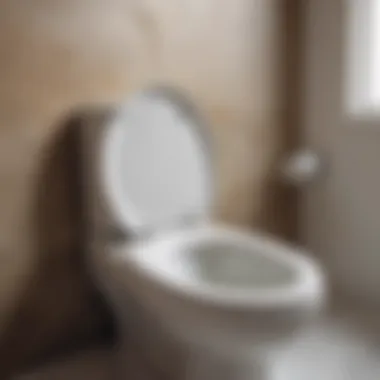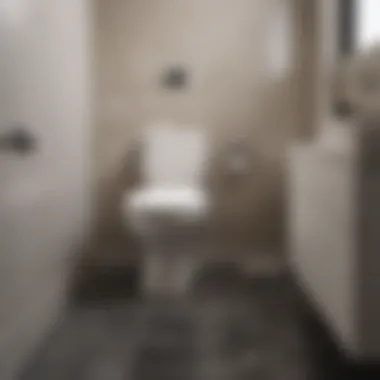Can Hot Water Effectively Unclog Your Toilet?


Intro
Clogged toilets are a common household issue that can cause significant inconvenience. Many homeowners often wonder about the effectiveness of different unclogging methods, particularly the use of hot water. This approach raises questions about its practicality and potential dangers. Understanding the science behind toilet clogs can help inform decisions regarding unclogging methods.
In this article, we will explore whether hot water can effectively unclog a toilet, analyze the underlying causes of clogs, and review alternative unclogging techniques. Homeowners and property managers will benefit from this knowledge, particularly when it comes to troubleshooting and maintaining plumbing systems.
Understanding Toilet Clogs
Toilets can become clogged for various reasons. Some common causes include:
- Excessive toilet paper usage
- Foreign objects that obstruct the drain
- Accumulation of waste over time
- Pipe blockages from mineral build-up
Each of these situations requires a tailored approach for unclogging. For example, attempting to forcefully flush foreign objects may worsen the situation. Instead, knowing the nature of the clog enables more effective solutions.
The Science Behind Hot Water
Hot water can be an effective tool for unclogging a toilet, but it requires certain conditions to work effectively.
- Temperature: Water that is too hot can damage toilet components, particularly plastic parts. Ideally, hot water should be around 120-140 degrees Fahrenheit.
- Movement: Pouring hot water from a height can introduce additional force into the clog. This can help break down blockages through a combination of heat and gravitational force.
However, relying solely on hot water is not always sufficient. Its effectiveness often varies based on the nature and severity of the clog.
Practical Use of Hot Water
To use hot water for unclogging a toilet:
- Boil water on a stove or heat it in a kettle.
- Carefully pour the hot water into the bowl from waist height to create pressure.
- Wait a few minutes to see if the water drains.
If the toilet does not unclog, additional methods may need to be applied.
"Hot water can be an ally in unclogging toilets, but it is not a cure-all solution."
Alternative Methods for Unclogging Toilets
If hot water fails, various alternative methods are available:
- Plunger: A basic yet effective tool for most clogs, it relies on suction to dislodge blockages.
- Toilet Auger: This device can reach deeper into pipes than a plunger. It is useful for stubborn clogs.
- Enzyme-Based Cleaners: These can break down organic materials in the pipes.
- Wet/Dry Vacuum: This can sometimes extract foreign objects causing the clog.
Each of these options presents its own advantages and limitations depending on the severity of the clog.
Ending
Understanding whether hot water can unclog a toilet enhances the capabilities of homeowners and property managers alike. It helps in developing appropriate approaches to bathroom maintenance. While hot water may work in some cases, it is crucial to recognize the potential risks and have alternative methods on hand. By combining knowledge with practical action, effective toilet maintenance is within reach.
Understanding Toilet Clogs
Understanding how toilet clogs occur is key to addressing them effectively. Toilets are designed to handle waste and water, but they can become blocked due to various factors. Recognizing the reasons behind these clogs can help homeowners choose the appropriate methods for remediation, including the potential use of hot water.
When a clog does form, the impact on daily life can be significant. A clogged toilet can disrupt routines, cause stress, and lead to costly repairs if not handled properly. Therefore, understanding the mechanics of clogs not only equips one with problem-solving skills but also preventative measures to avoid future issues.
Several factors contribute to the formation of clogs, so a deeper dive into these can provide clarity. This knowledge is invaluable in evaluating if hot water will serve as a remedy in specific cases.
What Causes Toilet Clogs?
Toilet clogs primarily occur when waste cannot move through the plumbing system. There are many reasons for this, including overloading the toilet with paper, toys, or other foreign objects. The design of the toilet itself can play a role; a low-flow toilet, for instance, may not use enough water to push waste effectively. Blockages in the pipes can also cause issues, often due to debris buildup over time. Recognizing these causes can help address the root of the problem, not just its symptoms.
Common Materials Leading to Clogs


Common materials that lead to toilet clogs include:
- Toilet paper: While designed to disintegrate, excessive use can lead to blockages.
- Hygiene products such as tampons and wipes: These items do not break down and often become lodged in pipes.
- Foreign objects like toys or dental floss: Anything other than waste and toilet paper can cause significant issues.
- Biological build-up: Accumulation from waste itself can lead to slow drainage over time.
Understanding these materials can guide users in making informed decisions about what can and cannot safely be flushed.
The Role of Water in Clogging
Water plays an essential role in the functioning of a toilet. The correct amount supports the swift passage of waste through the plumbing. However, the water can also contribute to clogging, especially in the case of hard water, which can lead to mineral deposits in pipes over time.
Moreover, low water levels in the tank may affect how efficiently waste is cleared. A well-functioning toilet perfects the balance between waste and water. Therefore, the considerations surrounding water, its amount, and quality become crucial when assessing clog issues.
Ultimately, understanding these elements of toilet clogs lays the groundwork for exploring various unclogging methods, including the practicality of using hot water.
The Science Behind Hot Water
Understanding the science behind hot water is crucial when considering its efficacy for unclogging toilets. The mechanism underlying how hot water interacts with different materials and obstructions can delineate its effectiveness. In this section, we will examine the temperature and how it affects clog dissolution, the consequences of using hot water on various materials, and the principle of thermal expansion and how it interacts with plumbing systems.
Temperature and Clog Dissolution
Temperature is a key factor in the performance of hot water as a tool for resolving clogs. When water is heated, it possesses greater energy, allowing it to break down the substances causing a blockage. Higher temperatures can dissolve fats, oils, and other organic matter more effectively than cold water. This can be particularly useful in toilets where clogs are caused by waste and paper products. The ideal temperature must be high enough to assist in the dissolution process without risking damage to plumbing fixtures or pipes.
"Using hot water can sometimes dislodge the materials trapped in the pipes, leading to a quick removal of the clog."
However, caution should be taken, as boiling water may crack porcelain toilets or damage plastic pipes. The effectiveness of hot water can depend on how long it is poured and the temperature reached.
Effects of Hot Water on Different Materials
The impact of hot water varies significantly across different materials found in toilet plumbing systems. For instance, ceramic and porcelain, common in toilets, are generally resilient to hot water. However, prolonged exposure to extreme temperatures can cause crack. It is generally recommended to use hot—not boiling—water to avoid such risks.
Other substances, like plastic pipes, can be sensitive to high temperatures. Hot water may soften some plastic materials, potentially leading to deformities or leaks. To optimize the unclogging process, it is important to consider the material composition of the plumbing system before applying hot water.
Mechanics of Thermal Expansion
Thermal expansion is a physical process whereby materials expand when heated. This principle plays an important role in how hot water can assist in unclogging a toilet. When hot water enters a cool pipe, the sudden temperature rise may cause components of the clog to expand at varying rates. This differential expansion can help to break bonds within the blockage, making it easier for the hot water to dislodge debris.
Nonetheless, there is a threshold to this effect. Extreme temperature variations might lead to stress fractures in the plumbing infrastructure. Knowing how much heat a specific piping material can tolerate is essential before utilizing hot water as a method to clear a clog.
In summary, while hot water may present a manageable method to address toilet clogs, understanding the underlying science can guide effective and safe application.
Procedure for Using Hot Water
Understanding how to apply hot water to a toilet clog effectively is crucial to the success of this method. Many homeowners find themselves wondering if simply pouring hot water into the bowl is sufficient. The process involves more than that; it requires specific temperature levels, correct application techniques, and awareness of common pitfalls. If executed properly, using hot water can be a viable solution for clogs resulting from organic material and toilet paper.
Recommended Temperature Range
The temperature of the water plays a pivotal role in unclogging toilets. While it is commonly thought that boiling water is the magic solution, it is worth noting that boiling water at 100 degrees Celsius can be too harsh. This might cause damage to the porcelain of the toilet or push the clog further down the drain. Typically, a recommended temperature range would be between 50 to 80 degrees Celsius. This temperature is hot enough to soften organic matter without risking damage to the toilet.
Step-by-Step Application Process
Using hot water effectively requires an organized and methodical approach. The following steps outline the process:
- Prepare the Space: Ensure the surrounding area is clear from any obstacles. Possible spill during the procedure makes having towels or a mop handy advisable.
- Boil Water: Heat water to a temperature within the recommended range, avoiding a full boil to prevent damaging the toilet.
- Pouring Technique: Gradually pour the hot water into the toilet bowl, aiming for a height of about one meter. This height allows the water to create some force when it hits the clog.
- Wait: Allow the hot water to sit for approximately 10 to 15 minutes. This waiting period enables the heat to penetrate the clog effectively.
- Flush: After waiting, attempt to flush the toilet. If the water drains normally, the clog has likely been resolved. If not, further action may be needed.
Avoiding Common Mistakes
Several errors are frequently made when using hot water for unclogging toilets, which can lead to unsuccessful attempts or even damage. Here are some common mistakes to avoid:


- Using Boiling Water: As mentioned before, boiling water can crack the porcelain, so it is crucial to stay within the safe temperature range.
- Too Rapid Pouring: Pouring the water too quickly may not allow for the desired effect; a steady and controlled pour is essential.
- Neglecting Previous Attempts: If using hot water follows another unsuccessful unclogging method, it is useful to consider the nature of the clog first. Combining various techniques without understanding the problem may worsen the situation.
To maximize effectiveness, consider combining the use of hot water with a plunger or a plumbing snake if the clog remains
Assessing the Efficacy of Hot Water
Understanding the effectiveness of hot water in unclogging toilets is crucial for homeowners and property managers alike. This method may seem simple and easily applicable, but its performance can vary significantly based on specific factors, such as the type of clog and the materials involved. When evaluating hot water as a potential solution, it is essential to consider multiple aspects.
Real-World Experiences and Outcomes
Many individuals have shared their experiences regarding the use of hot water to address toilet clogs. In some cases, users have reported positive results. They found that using boiling water helped dissolve certain types of blockages, such as soap scum and grease. For instance, homeowners dealing with minor clogs often describe successful resolutions by pouring hot water directly into the toilet bowl.
However, such positive outcomes are not universal. Some users found that boiling water did not resolve their issues, particularly in the presence of solid obstructions like toilet paper or foreign objects. The variability of results highlights the subjective nature of clog experiences.
Studies on Hot Water Effectiveness
Research regarding the utilization of hot water for unclogging toilets is limited. Studies suggest that the temperate of the water can significantly impact its effectiveness in dissolving materials. According to the American Water Works Association, water above 140°F can begin to assist in breaking down certain clogs. However, the actual success rate depends heavily on the nature of the blockage itself.
Several experiments indicate a moderate success rate when hot water is applied carefully to soften specific materials. Yet, conclusions drawn from these studies must be considered with caution. They do not guarantee a one-size-fits-all approach, as the complexities of toilet plumbing can yield unpredictable results.
Limitations and Considerations
While hot water can be a valuable tool in unclogging toilets, it is essential to acknowledge its limitations. Not every clog will respond to the application of hot water. Clogs caused by solid objects or basic plumbing issues may persist despite efforts.
Moreover, extremely hot water could potentially lead to damage in certain pipes, especially older plastic plumbing systems. This situation could result in leaks or further complications, adding to the homeowner’s concerns.
In light of these factors, evaluating when and how to apply hot water is critical to avoid unnecessary repairs.
"Using hot water may seem a simple solution, yet it is not always effective and can sometimes cause more harm than good."
In essence, homeowners should proceed with caution and weigh the potential benefits and risks of using hot water as a clog remedy.
Alternative Unclogging Methods
In addressing toilet clogs, it is crucial to consider alternative unclogging methods alongside hot water. Understanding these methods can provide homeowners and property managers with a comprehensive toolkit for dealing with stubborn blockages. Each method has its own advantages and disadvantages, which can affect their applicability based on the nature of the clog.
Plunging Techniques
Plunging is a fundamental method to unclog toilets. It involves using a plunger, typically made of rubber, to create a seal over the toilet drain. This allows the user to generate suction and push downward force to dislodge the clog. It is particularly effective for organic blockages, such as toilet paper or waste. To use a plunger effectively:
- Ensure the toilet bowl has enough water to cover the plunger.
- Position the plunger over the drain and push down firmly to create suction.
- Pull up sharply to break the suction, then push down again.
Repeat this process several times. It may take a few attempts to see results.
Chemical Drain Cleaners
Chemical drain cleaners offer another option for tackling toilet clogs. These products often come in liquid or gel form and contain potent substances designed to dissolve various materials causing the blockage. While effective, they come with several considerations:
- Effectiveness: Some chemical cleaners work better on certain types of clogs over others.
- Safety Risks: These products can be hazardous. Always wear gloves and maintain proper ventilation.
- Pipe Damage: Prolonged use can damage plumbing systems, especially older pipes.
Follow the manufacturer's instructions carefully to mitigate risks while using chemical drain cleaners.
Professional Plumbing Solutions
When other methods fail or if the clog is recurring, seeking professional plumbing services may be necessary. Licensed plumbers have the tools and expertise to diagnose and resolve complicated issues. They can:
- Use specialized equipment, such as drain cameras, to identify blockages.
- Provide solutions that might not be possible for a homeowner.
- Offer lasting solutions rather than temporary fixes.


Employing professional services can be a wise investment, especially for persistent or severe clogs. Sometimes, the cost of professional help is justified in avoiding potential water damage and costly repairs down the line.
Important Note: Not all methods work for every clog. It is essential to analyze the situation and choose the most suitable approach when addressing a toilet blockage.
Safety Precautions
In any effort to address toilet clogs, safety precautions are paramount. The application of hot water may seem a simple solution but there are numerous factors to consider. These precautions not only protect the person attempting the unclogging but also safeguard the integrity of the plumbing system.
When it comes to unclogging toilets, the risks range from personal injury due to scalding hot water to potential damage within the plumbing structure. Therefore, understanding how to protect yourself while effectively addressing a clog is essential.
Protecting Yourself and Your Property
The first step in ensuring safety during the unclogging process is to assess the temperature of the water you plan to use. Hot water can exceed 200 degrees Fahrenheit, which is dangerously close to the boiling point. If this water comes into contact with skin, severe burns can occur. It is advisable to wear heat-resistant gloves and long sleeves while handling hot water.
Also, when pouring hot water, ensure that you do so from a safe height and in a controlled manner to prevent splashes or spills that could harm floors or other surfaces. If you have children or pets, they should be kept at a safe distance during the process.
Moreover, it is important to consider the material of the toilet and the pipes. Certain materials may not withstand extreme temperatures, leading to cracks or breaks that could cause leaks. Using hot water in a porcelain toilet is generally safe, but older pipes, especially those made from plastic, could react poorly.
Recognizing Signs of Damage
A critical aspect of keeping your toilet functional is recognizing the signs of damage. If hot water has been used previously, look for any strange noises or unusual smells during or after the process. These could indicate overheating or structural issues.
Cracks or chips on the toilet bowl are a clear signal that it may not tolerate hot water as well as it should. Additionally, watch for slow draining after attempting a hot water remedy. This behavior can indicate pipe damage or further clogs—issues less likely to resolve with hot water alone.
In instances where these signs are evident, it is prudent to halt any DIY attempts and consult a professional plumber for a comprehensive evaluation of the situation. Understanding these precautions can prevent minor household problems from escalating into costly repairs.
When to Seek Professional Help
Determining when to contact a professional plumber is a critical aspect of managing toilet issues, particularly in the context of persistent clogs. Homeowners may initially attempt DIY methods, including the use of hot water, plungers, or chemical cleaners. However, not all situations can be resolved with these approaches. Recognizing the signs that indicate the need for professional intervention can save time, frustration, and possibly prevent further damage to your plumbing system.
Persistent Clogs
Persistent clogs can be a significant indication that professional assistance is required. If a toilet consistently becomes blocked despite repeated attempts to clear it, this signals an underlying issue. A repeated clog might stem from several factors including:
- Build-up of waste: Over time, organic material and waste can create a substantial barrier.
- Narrow pipes: Old or corroded plumbing can restrict flow and lead to clogs.
- Foreign objects: Items inadvertently flushed can create blocks not easily addressed with plungers or hot water.
In such cases, a plumber can conduct a thorough inspection, often employing techniques like video pipe inspection to diagnose the problem accurately and formulate a solution that DIY methods cannot achieve.
Complications Beyond Simple Clogging
Complications may arise that extend beyond the realm of a simple clog. Problems such as leaky pipes, tree root intrusion, or serious blockages in the sewer line may not only affect the toilet but can also impact the entire plumbing system. It is prudent to seek professional help if you notice:
- Water backup in multiple fixtures: If other drains are backing up when the toilet is clogged, this may indicate a venting or sewer line issue.
- Unusual smells: Foul odors can signify that waste is not flowing correctly through the system.
- Frequent backups: Regular issues indicate a deeper problem within the plumbing setup.
Therefore, while using hot water can sometimes alleviate minor clogs, knowing when to seek professional help is essential for maintaining an efficient and effective plumbing system. > Ignoring warning signs can lead to costly repairs down the line.
Being proactive about plumbing issues and seeking timely help from experts can ultimately save both money and stress.
The End and Recommendations
Understanding the effectiveness of hot water for unclogging toilets is important for homeowners. Clogs are a common issue, and knowing how to address them can save time and money. This article has explored various aspects of toilet clogs and the potential role of hot water as a solution. The conclusions drawn highlight both the merits and limitations of using hot water, providing a balanced view for readers.
The analysis presented earlier underlines that hot water may not always be a foolproof method for clearing clogs, especially in severe cases. However, in certain situations, it can effectively dissolve materials that contribute to a blockage. Homeowners should consider the type of clog they are dealing with and assess the appropriate methods based on their specific circumstances. The key takeaway is to evaluate the effectiveness of hot water against other methods, keeping safety in mind.
Summary of Findings
- Potential Effectiveness: Hot water can aid in breaking down some materials that cause toilet clogs, such as soap scum or grease.
- Temperature Sensitivity: Using water that is too hot can damage certain parts of the toilet, including the tank and the ceramic.
- Alternative Solutions: Not all clogs respond well to hot water. Techniques such as plunging or chemical cleaners may be required in more stubborn cases.
- Importance of Assessment: Homeowners should first try to determine the nature of the clog before selecting a method. This can prevent unnecessary damage to plumbing.
Overall, it is critical to approach toilet clog issues with a clear understanding and proper tools or methods.
Practical Tips for Homeowners
- Assess Clog Type: Identify if the clog is due to foreign objects, excessive waste, or buildup before applying hot water.
- Temperature Matters: Use warm water instead of boiling water to avoid damaging the toilet. Aim for water around 120 to 140 degrees Fahrenheit.
- Application Method: Pour the hot water gradually from waist height, which helps the water flow down and reach the clog without splashing.
- Combine Methods: If hot water doesn't work, consider following up with a plunger or a drain snake.
- Monitor for Repeat Issues: If clogs continue to occur frequently, it might be worth evaluating the home’s plumbing to identify structural issues.
By keeping these recommendations in mind, homeowners can better manage toilet clogs, thereby enhancing their overall maintenance strategies.















